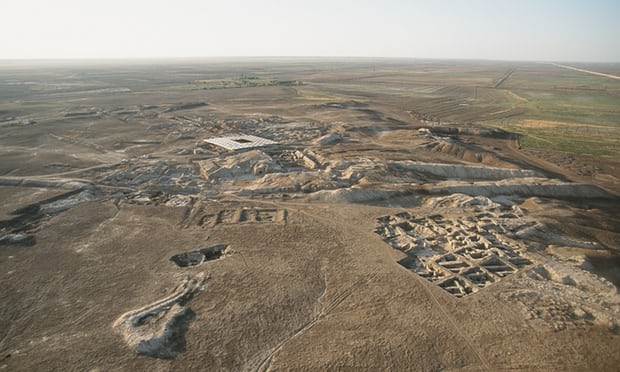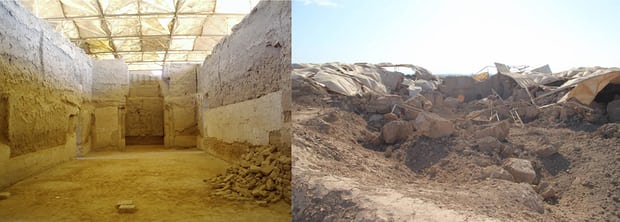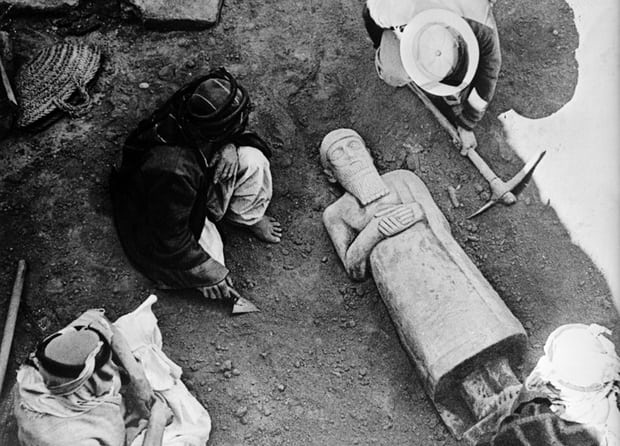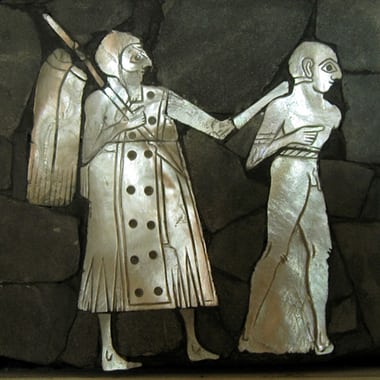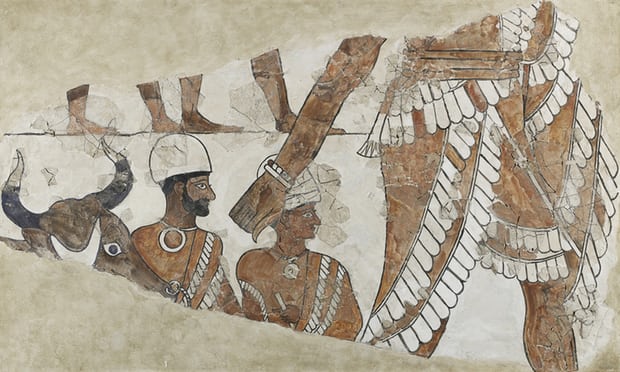DepthReading
Destruction at the ancient site of Mari in Syria
Aerial view of Mari before the arrival of IS. The protective roof over the palace area is visible at the centre. Photograph: Courtesy of the Mission Archéologique Française de Mari
Three weeks ago, the Syrian antiquities directorate released new photos showing another devastated archaeological site. Outside Syria the news has received fairly limited press attention, except in France, where Mari, the site in question, is much better known. French archaeologists have been excavating at Mari since 1933, the most recent expedition running until 2010 when the Arab Spring and growing unrest made the site inaccessible. In light of the level of damage which is now evident, perhaps it’s worth sparing a moment to look at why Mari matters to archaeologists, historians and the cultural heritage of Syria.
When Islamic State emerged, the part of Deir ez-Zor province in which Mari lies was one of the first areas to fall under its control in early 2014. Under IS, the site suffered an immediate explosion of looting; satellite images revealed the change from archaeological site to lunar landscape in a matter of months. More than 1,500 new looting pits were recorded at Mari between 2013 and 2015, likely representing the removal of a huge quantity of ancient objects, sold into the illegal antiquities market to fund Isis and its war.
New looting pits identified at Mari between March and November 2014. Photograph: Courtesy of the Mission Archéologique Française de Mari
Sadly, this is a story common to many archaeological sites across the region, but Mari isn’t just another site. For archaeologists it’s one of the most important sites so far excavated for those interested in understanding the great urban centres of Bronze Age Mesopotamia, or in diving into the turbulent politics of the second millennium BC.
Mari was home to an extraordinary palace. The earliest major structure dates to around 2500-2300 BC, and part of this early palace was restored and preserved at the site, providing a unique opportunity to walk through a third millennium BC Mesopotamian palace, standing almost to its roof beams.
This palace area is now very badly damaged. Its protective roof was compromised by a sand storm in 2011, and the security situation at that time left it impossible to make repairs, but the recently released photos show that large parts of the palace’s 2m thick walls have now collapsed. Prof Pascal Butterlin, who directed excavations at the site up until 2010, believes such a level of destruction suggests that explosives, either ground based or more likely from air strikes, were probably involved, adding to the damage caused by looting for financial gain. Butterlin gave a paper detailing the plight of Mari at the International Congress on the Archaeology of the Ancient Near East conference in Munich two weeks ago, to general dismay.
The palace of Mari as I last saw it in 2008 (left), and the palace as it appears in the new photos released by the Syrian Directorate-General of Antiquities and Museums (right) . Photograph: Mary Shepperson / Syrian Directorate-General of Antiquities and Museums website
For archaeologists and historians, Mari’s royal palace is more famous in its later form. In around 1800 BC the palace was remodelled and expanded by the Lim dynasty and the excavation of this building has provided the most complete picture available of the life of a royal palace and the functioning of a Bronze Age city state. This is in part due to the good preservation of the architecture and the almost complete excavation of the palace’s 300 rooms, but also to the 25,000 cuneiform tablets recovered during the excavations, which mostly date to this time.
The texts preserved on the tablets have left us the names of the rulers of Mari, provided a wealth of detail about the city and its people, and opened an exceptional window on the politics and diplomacy of the ancient Near East through the preservation of royal letters between the kings of Mari and the rulers of neighbouring kingdoms.
Ruling Mari wasn’t an easy job; the city was surrounded by more powerful kingdoms and beset by frequent internal troubles. King Yaggid-Lim was killed by his servants, while Yahdun-Lim was assassinated by his own son, who in turn was also assassinated after a reign of just two years. The best-known king of Mari was Zimri-Lim; a contemporary of the mighty Hammurabi of Babylon, famous for the earliest surviving law code.
The statue of Ishtup-Ilum emerging from the palace throne room in 1936. Photograph: Courtesy of the Mission Archéologique Française de Mari
Zimri-Lim, whose father also seems to have been assassinated by untrustworthy servants, managed to wrestle Mari back from a rival royal house. He married Shibtu, a princess from the kingdom of Yamad, centred at modern Aleppo. They had at least eight daughters and many letters between the king and his grown-up daughters survive to illustrate a close and fond fatherly relationship.
Shell inlay from Mari, showing a soldier leading off a bound prisoner. Photograph: Courtesy of the Mission Archéologique Française de Mari
Zimri-Lim was less successful in his relationship with Hammurabi. After being an ally of Babylon in its wars with Elam and the city state of Larsa, the diplomatic relationship between Zimri-Lim and Hammurabi gradually soured, culminating in a Babylonian army being dispatched to conquer Mari in 1761 BC. It’s impossible to tell how much more of this history may have been hacked out of the ground by the IS-sponsored looters, written on tablets which were sold to fund the fighting.
Zimri-Lim disappeared from the historical record when his city fell, presumably because he didn’t survive the encounter, but his palace did survive along with the records of his fourteen-year reign.
The palace constructed by the kings of Mari was of unusual magnificence, and the diplomatic texts suggest it was famous in its day as one of the largest and most luxurious royal palaces in existence, the envy of other rulers. The huge courtyards were planted with palm trees and the walls of the palace were painted with elaborate scenes and decorative designs, including a large fresco showing the investiture of Zimri-Lim as King, now displayed in the Louvre. The palace’s chapel contained a life-sized statue of a goddess, which was drilled through so that real water could run from the mouth of the vase held in the goddess’ hands. Sadly, the palace chapel and all the royal reception rooms are now a mass of huge looters pits.
A wall painting from Zimri-Lim’s palace known as ‘The Ordinator of the Sacrifice’ (c. 1780 BC). The large figure is the king, depicted presiding over a ritual sacrifice. Now in The Louvre. Photograph: Courtesy of the Mission Archéologique Française de Mari
Given the wonders of the palace of Mari and the importance of this site, it’s disappointing that the destruction of the palace and the plundering of the site in search of tablets and other saleable objects hasn’t received more attention. The first explanation is that cultural destruction in the Middle East has been so widespread in recent years that it’s ceased to be news-worthy in all but the most extreme cases, which is a depressing thought. A second disadvantage Mari has over more high-profile sites, such as Palmyra, is that its buildings were made of mud, and not the classical stonework which produces photogenic ruins and screams its artistic worth to a general audience. Nevertheless, Mari deserves to be considered as a loss on the same scale as any of the more celebrated sites to have suffered during the Isis conflict.
- For more information, visit the Mari project website, which includes a virtual tour of Zimri-Lim’s royal palace
Category: English
DepthReading
Key words:

